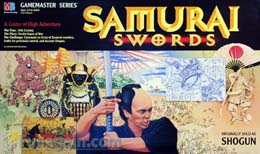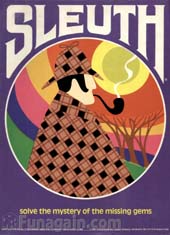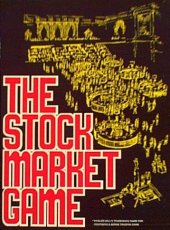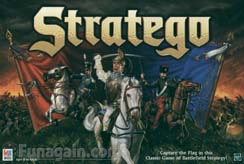
Home
Forum
Friends & Foes
Games
Reviews & Info
BattleTechnical
Radio Control
Lamborghini
T-Maxx
Mini-Z
Showcase
Art & Fantasy
Art Gallery
Creature
Pics
Webmaster
Links
Games - S
| INDEX | # | A | B | C | D | E | F | G | H | I | J | K | L | M | N | O | P | Q | R | S | T | U | V | W | X | Y | Z |
-
Samurai Swords (formerly Shogun) - Manufacturer: Milton Bradley / Hasbro - Year: 1995
Review by: Nathaniel Dragon - My Photos  Another
game from the Milton Bradley GameMaster Series, this one is based in
fuedal Japan during the 16th century. Player combat each other, using
Bowmen, Swordsmen, Ronin (mercenaries), Gunners, and Spearmen, to conquer
territories and become the "Shogun".
Another
game from the Milton Bradley GameMaster Series, this one is based in
fuedal Japan during the 16th century. Player combat each other, using
Bowmen, Swordsmen, Ronin (mercenaries), Gunners, and Spearmen, to conquer
territories and become the "Shogun".
Setup for the game is random, determined by dealing territory cards out to each player, so the positioning of the game will be different each time. After players place there initial units, reinforcements are placed to strength your focus points (primarily in your most occupied area).
After setup play begins with planning. This is done secretly by placing coins (Koku) into bins which pays for your turn order, building castles and fortresses, and combat units (regular units, mercenaries, and the ninja - which acts as an assassin/spy).
For players who decide not to pay for their turn order, they "Draw Swords". One player holds the set of plastic swords in their hand and one-by-one each player draws a sword. The sword has a number of diamonds on the blade which corresponds with the order in which the player with play in that turn.
Combat is determined with dice. Each unit has a set strength, with Bowmen being the best while Gunners and Spearmen (which are peasants) are the weakest. Each player also starts with 3 armies, lead by a Daimyo. If a player loses all 3 Daimyos, that player is out of the game. In order to win the game, a player must eliminate the other Daimyos or capture 35 territories.
This is an great game, where you can set a long term strategy, but be ready to see the situations change drastically in each turn. Compared to others in the GameMaster Series, I would regularly choose this over Axis & Allies - since the game will be different each time, but Conquest of the Empire will probably be played more often - due to the long play time needed for Samuri Swords (nearly 7 hours in our recent game).
-
Scotland Yard - Manufacturer: Milton Bradley - Designer: Schlegel; Garrels; Ifland; Burggraf; Scheerer; Hormann - Year: 1982 - $27.95 (1996 remake) AT FUNAGAIN GAMES*
Review by: Nathaniel Dragon  This
is an interesting detective game for 3-6 players. One player is Mr.
X - a fugitive on the loose in London. The other players take the role
of detectives - attempting to locate and catch Mr. X. The game board
is a map of London which shows routes for various modes of transportation:
Taxi, Bus, Underground (subway), and Ferry Boat. From points on the
board players use tickets for an available form of transportation to
get to another point. Taxi moves the slowest - moving about one block
away for each ticket. Bus moves a little quicker, and Underground moves
the fastest - often skipping past about 4 points. The Ferry Boat also
moves quickly down the river, but this transportation is only available
to Mr. X, the detectives must cross the river on bridges. The game is
over when Mr. X is caught or the detectives run out of tickets to move.
This
is an interesting detective game for 3-6 players. One player is Mr.
X - a fugitive on the loose in London. The other players take the role
of detectives - attempting to locate and catch Mr. X. The game board
is a map of London which shows routes for various modes of transportation:
Taxi, Bus, Underground (subway), and Ferry Boat. From points on the
board players use tickets for an available form of transportation to
get to another point. Taxi moves the slowest - moving about one block
away for each ticket. Bus moves a little quicker, and Underground moves
the fastest - often skipping past about 4 points. The Ferry Boat also
moves quickly down the river, but this transportation is only available
to Mr. X, the detectives must cross the river on bridges. The game is
over when Mr. X is caught or the detectives run out of tickets to move.
This sneaky game of cat and mouse is really a deduction game. Most of the time the only clue that the detectives have of where Mr. X is at are the tickets that he uses to get from one point to another. Most locations don't have all modes of transportation available, so you must pay attention to where Mr. X popped up last and try to follow his footsteps from there. The Mr. X playing peice will only show up on the board a max of 5 times in the game. These visible points are very critical for the detectives. Its not easy to catch a clever Mr. X, but Mr. X must also watch his step and be sure that he doesn't trap himself in a corner.
I've played this game with my wife and parents, and even though it may look and seem like this is a kids game at first glance - this game would be tough for a kid to figure out what is happening in the game. In my opinion its best for the game to be kept for adults with a game of Clue or Clue: Master Detective being much closer to what younger players could understand. Scotland Yard is easily one of my favorite games.
Although the version of the game I have is out-of-print, Ravensburger (the original Manufacturer) has published an updated version that is available. My understanding is that the updated version is the same game with some visual changes.
-
Settlers of Catan - Manufacturer: Mayfair Games - Designer: Klaus Teuber - Year: 1997 - $23.95 AT FUNAGAIN GAMES*
Review by: Nathaniel Dragon - My Photos  Settlers
of Catan, from Mayfair Games, quickly became one of our favorite games.
This game is imported from Germany, the homeland of many great games
made for players age 13+.
Settlers
of Catan, from Mayfair Games, quickly became one of our favorite games.
This game is imported from Germany, the homeland of many great games
made for players age 13+.
The basic game is for 3 or 4 players, although expansions and variations allow for 2-6 players. The goal of each player is to be the first to capture 10 victory points, by building settlements, roads, and cities with the resources of the island: Brick, Grain, Lumber, Ore, and Wool. There is no combat in the game, but placement of pieces on the board can threaten and even ruin the plans of other players. Players can also gain victory point with developement cards, which may have a Library, Soldiers, and even cards that allow you to collect the resources that you need to build.
Settlers of Catan is a game that is sure to be a hit with gamers and non-gamers alike. The game is different than any I've ever played before, and it has been a little difficult to describe the rules to new players, but after a few turns, even the new players catch on pretty easily. Everyone that has played it with us has enjoyed the game.
-
Settlers of Catan Card Game - Manufacturer: Mayfair Games - Designer: Klaus Teuber - Year: 1998 - $14.95 AT FUNAGAIN GAMES*
Review by Doc Folly - My Photos -
 Settlers
of Catan, the 2 player card game, is a good card game for those who
love to hate their enemy. It is quite different from the board game.
Players compete to build the most settlements, cities and land in order
to win. A roll of the dice determines which of the territories will
produce resources and determine some actions that will be performed.
Each player battles his opponent using different cards to gain for himself
and/or to remove opponent's assets. Players also may trade resources,
but trading is very competitive. Having only one opponent makes players
less likely to be willing to trade. Like in many games, familiarizing
yourself with the cards and game play is the best defense against frustration
during the game. Overall, it is a good, competitive game for two players.
Settlers
of Catan, the 2 player card game, is a good card game for those who
love to hate their enemy. It is quite different from the board game.
Players compete to build the most settlements, cities and land in order
to win. A roll of the dice determines which of the territories will
produce resources and determine some actions that will be performed.
Each player battles his opponent using different cards to gain for himself
and/or to remove opponent's assets. Players also may trade resources,
but trading is very competitive. Having only one opponent makes players
less likely to be willing to trade. Like in many games, familiarizing
yourself with the cards and game play is the best defense against frustration
during the game. Overall, it is a good, competitive game for two players.
-
Shadowlord! - Manufacturer: Parker Brothers - Year: 1983
Review by: Nathaniel Dragon - My Photos  Shadowlord!
has got to be one of the most difficult Parker Brothers games to understand
the rules from reading them. I had read through the rules before getting
together with Jason and he read through the rules as we set up the game.
It took us nearly 3 hours to understand the game enough to play it right.
Even then we felt like the instructions weren't very clear on some rules.
Shadowlord!
has got to be one of the most difficult Parker Brothers games to understand
the rules from reading them. I had read through the rules before getting
together with Jason and he read through the rules as we set up the game.
It took us nearly 3 hours to understand the game enough to play it right.
Even then we felt like the instructions weren't very clear on some rules.
After playing the game once we felt that the game had a very interesting system and was worth playing more but there was still more discussion on the way that rules were interpreted. We finally agreed on some standards to play so we continued in our second game. After that game there were more situations that came up which again were only vaguely described in the rules so another revision was made in our interpretation.
If you're interested in playing the game, hopefully you can find someone else who knows the rules - otherwise you'll probably be confused for the first couple games. In the end I get the feeling that Shadowlord! could have somehow been simlified for younger players, especially since the Fantasy/Science Fiction theme seems geared more toward younger players.
-
Sleuth - Manufacturer: Avalon Hill - Designer: Sid Sackson - Year: 1981
Review by: Nathaniel Dragon  This
is a detective game designed by Sid Sackson and manufactured by Avalon
Hill. The role of the players is to find out which gem is missing. The
game consists of two types of cards - gem cards and search cards. At
the beginning of the game, one gem card is removed from play and the
remaining cards are dealt out evenly to the players with extras face
up in the center of the table. Players take turns using search cards
to find clues about what cards the other players have.
This
is a detective game designed by Sid Sackson and manufactured by Avalon
Hill. The role of the players is to find out which gem is missing. The
game consists of two types of cards - gem cards and search cards. At
the beginning of the game, one gem card is removed from play and the
remaining cards are dealt out evenly to the players with extras face
up in the center of the table. Players take turns using search cards
to find clues about what cards the other players have.
I think this is a good detective game, even though I haven't been quick enough to win the game yet. The different type of search cards make the game interesting when you don't always get to view the cards directly - you might only find out how many cards of a certain type someone has. Since I usually win when we play Clue and Clue: Master Detective, I was thinking that I would easily catch on to the strategy of this game. Although I haven't won yet, I still think it's a good, and challenging, detective game.
-
Solarquest - Manufacturer: Golden - Year: 1986
Review by: Nathaniel Dragon - If you are interested in a Monopoly-style real-estate game that is
"out of this world" you should check out Solar Quest. This is one of
the few games that I have held onto since I was a kid.
Players fly around the galaxy in space rockets, buying up the planets and the moons. Rent is increased for the amount of moons that you have in a group.
As you fly around the galaxy you must also keep track of your fuel. If a player runs out of fuel, he is stuck in space where he can only hope to drift to a fuel station before he is permanently lost in space (often caused by 'Red Shift' when fuel is too low). Fuel stations can be placed by players, but are also built in at Earth and the space docks which float around several planets.
Using optional rules, players may also blast their opponents with lasers to get some cash or even eliminate the player completely, of course taking their assets as they leave. This is an option that I almost always use, and has sometimes turned the game around completely.
The game has special cards, called 'Red Shift' cards, which players draw when doubles are rolled on the dice. This sometimes awards players with cash or just moves them around the board to different locations.
All in all, if you like Monopoly, but want some different twists, you'll probably like Solar Quest.
-
The Stock Market Game - Manufacturer: Avalon Hill - Year: 1970
Review by: Nathaniel Dragon - My Photos  First
of all, I became interested in this game initially because my wife and
I are studying about the stock market. The summary indicates that this
game will teach you how to play in the REAL stock market if you play
six games that are in the rules. Since getting the game last year we've
only played using the rules of the first 2 'games' but the game has
been quite fun and instructional. We are slowly grasping all the basic
and expert rules for the game and should move onto the next game soon.
One game is a set scenario of events in the history of the stock market
during the depression of 1929.
First
of all, I became interested in this game initially because my wife and
I are studying about the stock market. The summary indicates that this
game will teach you how to play in the REAL stock market if you play
six games that are in the rules. Since getting the game last year we've
only played using the rules of the first 2 'games' but the game has
been quite fun and instructional. We are slowly grasping all the basic
and expert rules for the game and should move onto the next game soon.
One game is a set scenario of events in the history of the stock market
during the depression of 1929.
Avalon Hill's The Stock Market Game doesn't use dice - the value of stock is determined by the interest of all the players. A stack of cards determine if the market is Bull (strong), Bear (weak), or Mixed. In each turn all players simultaneously determine which type of stock they will buy and sell, if any. A timer is set to give the players a deadline for transactions, afterward the broker processes the transactions of each player. Once that is complete, the trend card is flipped to determine how the strong the market is and the prices are adjusted accordingly. The winner is the player with the most value in cash and assets by the end of 12 turns.
Often times when we tell people about this game they seem disinterested, and anything beyond the basic rules seems to bog them down, but once we actually get them playing almost all are interested in playing again. This game lasts 1-2 hours depending on the extent of the rules that you are using and how well the players understand the game.
Stratego - Manufacturer: Milton Bradley - $14.95 AT FUNAGAIN GAMES*
Review by: Nathaniel Dragon Stratego is an old strategy game, originally published by Milton Bradley in 1961. The basic concept of the game is a turn-based capture-the-flag game for two-players. Each player secretly sets up their army, which has 10 different ranks of "men" along with "bomb" pieces and a "flag". Every game piece on the board appears the same from the backside, but the player sees the rank of their own piece. The opponent will only discover the rank of the piece through combat.
Stratego is an old strategy game, originally published by Milton Bradley in 1961. The basic concept of the game is a turn-based capture-the-flag game for two-players. Each player secretly sets up their army, which has 10 different ranks of "men" along with "bomb" pieces and a "flag". Every game piece on the board appears the same from the backside, but the player sees the rank of their own piece. The opponent will only discover the rank of the piece through combat.The game-board is rather simple, using rows and columns of squares to place pieces on. There are two "lake" obstacles in the central area of the board that take up 4 squares each. Players can move across the board by going around the lakes, either near the edge of the game board or through the center of the game board between the two lakes.
When players move their pieces close to opposing pieces one of the players may attack. The higher-ranking piece between the two is the winner, except in special circumstances. The Spy is the lowest-ranking piece on the board, but its special ability is to kill the Marshal (the highest-ranking piece). When a player attacks a bomb, that player's piece is killed. Miners have the ability to disarm bombs without getting killed.
As soon as one player attacks the opposing flag the game is over and the attacker is the winner. All in all, I'd highly suggest getting a copy of Stratego for adults and older children interested in a light wargame.
|
Looking for Something Else? |
in association with *prices and availability subject to change |